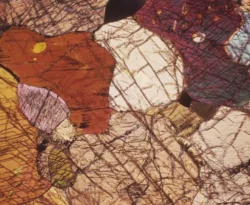There are three types of weathering which affect rock: physical, biological, and chemical. Chemical weathering, also known as decomposition or decay, is the breakdown of rock by chemical mechanisms.
How Chemical Weathering Happens
Chemical weathering does not break rocks into smaller fragments through wind, water, and ice (that’s physical weathering). Nor does it break rocks apart through the action of plants or animals (that’s biological weathering). Instead, it changes the chemical composition of the rock, usually through carbonation, hydration, hydrolysis or oxidation.
Chemical weathering alters the composition of the rock material toward surface minerals, such as clays. It attacks minerals that are relatively unstable in surface conditions, such as the primary minerals of igneous rocks like basalt, granite or peridotite. It can also occur in sedimentary and metamorphic rocks and is an element of corrosion or chemical erosion.
Water is especially effective at introducing chemically active agents by way of fractures and causing rocks to crumble piecemeal. Water may also loosen thin shells of material (in spheroidal weathering). Chemical weathering may include shallow, low-temperature alteration.
Let’s take a look at the four main types of chemical weathering that were mentioned earlier. It should be noted that these are not the only forms, just the most common.
Carbonation
Carbonation occurs when rain, which is naturally slightly acidic due to atmospheric carbon dioxide (CO2), combines with a calcium carbonate (CaCO3), such as limestone or chalk. The interaction forms calcium bicarbonate, or Ca(HCO3)2. Rain has a normal pH level of 5.0-5.5, which alone is acidic enough to cause a chemical reaction. Acid rain, which is unnaturally acidic from atmospheric pollution, has a pH level of 4 (a lower number indicates greater acidity while a higher number indicates greater basicity).
Carbonation, sometimes referred to as dissolution, is the driving force behind the sinkholes, caverns and underground rivers of karst topography.
Hydration
Hydration occurs when water reacts with an anhydrous mineral, creating a new mineral. The water is added to the crystalline structure of a mineral, which forms a hydrate.
Anhydrite, which means “waterless stone,” is a calcium sulfate (CaSO4) that is usually found in underground settings. When exposed to water near the surface, it quickly becomes gypsum, the softest mineral on the Mohs hardness scale.
Hydrolysis
Hydrolysis is the opposite of hydration; in this case, water breaks down the chemical bonds of a mineral instead of creating a new mineral. It is a decomposition reaction.
The name makes this one particularly easy to remember: The prefix “hydro-” means water, while the suffix “-lysis” means decomposition, breakdown or separation.
Oxidation
Oxidation refers to the reaction of oxygen with metal elements in a rock, forming oxides. An easily recognizable example of this is rust. Iron (steel) reacts easily with oxygen, turning into reddish-brown iron oxides. This reaction is responsible for the red surface of Mars and the red color of hematite and magnetite, two other common oxides.




